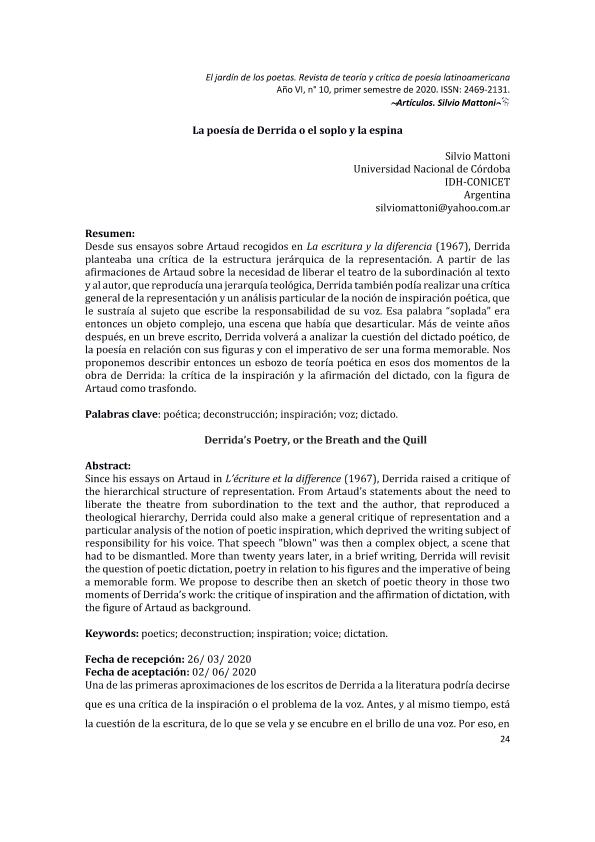Mostrar el registro sencillo del ítem
dc.contributor.author
Mattoni, Silvio Luis

dc.date.available
2021-10-25T17:28:15Z
dc.date.issued
2020-07
dc.identifier.citation
Mattoni, Silvio Luis; La poesía de Derrida o el soplo y la espina; Universidad Nacional de Mar del Plata. Facultad de Humanidades; El Jardín de los Poetas; VI; 10; 7-2020; 24-36
dc.identifier.issn
2469-2131
dc.identifier.uri
http://hdl.handle.net/11336/144966
dc.description.abstract
Desde sus ensayos sobre Artaud recogidos en La escritura y la diferencia (1967), Derrida planteaba una crítica de la estructura jerárquica de la representación. A partir de las afirmaciones de Artaud sobre la necesidad de liberar el teatro de la subordinación al texto y al autor, que reproducía una jerarquía teológica, Derrida también podía realizar una crítica general de la representación y un análisis particular de la noción de inspiración poética, que le sustraía al sujeto que escribe la responsabilidad de su voz. Esa palabra “soplada” era entonces un objeto complejo, una escena que había que desarticular. Más de veinte años después, en un breve escrito, Derrida volverá a analizar la cuestión del dictado poético, de la poesía en relación con sus figuras y con el imperativo de ser una forma memorable. Nos proponemos describir entonces un esbozo de teoría poética en esos dos momentos de la obra de Derrida: la crítica de la inspiración y la afirmación del dictado, con la figura de Artaud como trasfondo.
dc.description.abstract
Since his essays on Artaud in L’écriture et la difference (1967), Derrida raised a critique of the hierarchical structure of representation. From Artaud’s statements about the need to liberate the theatre from subordination to the text and the author, that reproduced a theological hierarchy, Derrida could also make a general critique of representation and a particular analysis of the notion of poetic inspiration, which deprived the writing subject of responsibility for his voice. That speech "blown" was then a complex object, a scene that had to be dismantled. More than twenty years later, in a brief writing, Derrida will revisit the question of poetic dictation, poetry in relation to his figures and the imperative of being a memorable form. We propose to describe then an sketch of poetic theory in those two moments of Derrida’s work: the critique of inspiration and the affirmation of dictation, with the figure of Artaud as background.
dc.format
application/pdf
dc.language.iso
spa
dc.publisher
Universidad Nacional de Mar del Plata. Facultad de Humanidades
dc.rights
info:eu-repo/semantics/openAccess
dc.rights.uri
https://creativecommons.org/licenses/by-nc-sa/2.5/ar/
dc.subject
POÉTICA
dc.subject
DECONSTRUCCIÓN
dc.subject
INSPIRACIÓN
dc.subject
VOZ
dc.subject.classification
Estudios Generales de Literatura

dc.subject.classification
Lengua y Literatura

dc.subject.classification
HUMANIDADES

dc.title
La poesía de Derrida o el soplo y la espina
dc.title
Derrida’s Poetry, or the Breath and the Quill
dc.type
info:eu-repo/semantics/article
dc.type
info:ar-repo/semantics/artículo
dc.type
info:eu-repo/semantics/publishedVersion
dc.date.updated
2021-09-06T15:45:41Z
dc.journal.volume
VI
dc.journal.number
10
dc.journal.pagination
24-36
dc.journal.pais
Argentina

dc.journal.ciudad
Mar del Plata
dc.description.fil
Fil: Mattoni, Silvio Luis. Consejo Nacional de Investigaciones Científicas y Técnicas. Centro Científico Tecnológico Conicet - Córdoba. Instituto de Humanidades. Universidad Nacional de Córdoba. Instituto de Humanidades; Argentina
dc.journal.title
El Jardín de los Poetas
dc.relation.alternativeid
info:eu-repo/semantics/altIdentifier/url/https://fh.mdp.edu.ar/revistas/index.php/eljardindelospoetas/article/view/4350
Archivos asociados
